All angiosperms produce flowers, but some of them just seem more amazing than others. Flowers come in all shapes, sizes, colors, and configurations of the “standard parts” (botanically speaking). This article is a brief introduction to a dozen plants (in no particular order) I’ve had the opportunity to see, most in habitat, that I think have really interesting and unusual flowers. These are primarily exotic, tropical things, with a range of plant types from trees and shrubs to vines and herbaceous plants.

Chiranthodendron pentadactylon is a rather undistinguished, tall (40-90 feet), fast-growing evergreen tree in the Sterculiaceae with large and shallowly lobed leaves. It’s the distinctive, claw-like flowers that inspired the common names of devil’s hand, monkey’s hand and monkey paw. They are deep red with five segmented stamens protruding from five petals that form a bowl shape. The stamens produce double rows of yellow pollen along each “finger” and curl to resemble curved claws as they age. In the wild the tree is pollinated by bats and birds sipping nectar from the cup formed from the petals. The flowers are followed by 3–4 inch long oblong, five-lobed woody capsules containing black seeds. The pre-Columbian Aztecs used the flowers for religious purposes, while the fruit has been used for years in traditional medicine to treat heart conditions, the bark is used as rope and the large leaves are used to wrap food. This tree is planted as an ornamental in mild climates well outside its native range in the cloud forests of southern Mexico and Guatemala.
Psychotria elata and other species are small understory trees native to Central America that get their common name of hot lips from the bright red bracts which resemble a pair of lips surrounding the inflorescence. The shiny basal bracts spread open to reveal tiny yellow or white tubular, star-shaped flowers which are pollinated by hummingbirds and visited by butterflies and other insects. The flowers are followed by small blue fruits which are eaten by birds who disseminate the seeds. This plant and others such as the very similar looking P. poeppigiana (which can be distinguished by hairs on the leaves and stem which P. elata does not have) flower and fruit year round to provide food for many bird species in all seasons. Native to tropical regions around the world, this genus in the coffee family (Rubiaceae) is one of the largest genera of flowering plants with over 1850 species. Wild coffee (P. nervosa), native from Florida to South America, gets its common name from the resemblance of the small red fruits to a coffee “bean”.

Aristolochia grandiflora is another plant native to Central America with very strange flowers that only last for two days, dangling on long pendant peduncles from the deciduous vines that scramble through trees and other vegetation. Instead of normal petals, plants in this large genus in the Aristolochiaceae which includes over 500 species have bizarre, pipe-shaped inflorescences. This particular species has, as the species epithet implies, huge flowers that are two inflated chambers with an intricate pattern of mottling and veins in maroon/brown and white. Since it is pollinated by flies it emits a rotten, dead animal smell to lure those pollinators inside through a tube to where the reproductive parts are in the utricle. Hairs on the inside of the tube act as a fly-trap, directing the fly inward and preventing it from leaving. The fly eats nectar produced on the wall of the utricle while pollen is released. The following day the hairs wither so the fly can escape, covered with pollen. Other tropical species are also lianas (woody vines), but those in temperate areas tend to be herbaceous perennials with heart-shaped leaves.

Ferraria crispa is one of many plants in the Iridaceae (iris family) that occur in South Africa. What makes this species different than most is that the three petals and three sepals of the flowers are an amazing and quite variable combination of velvety chocolate brown, maroon or almost black and rich cream or pale yellow, with spots and splotches and ruffled edges, and some with touches of blue. Sometimes known as Starfish lily or starfish iris, this extremely variable species almost looks like something from the ocean, with the crinkled petals covered with barnacles. Some selections or subspecies are fragrant (the odor is variously described as a vanilla fragrance to “unpleasant”) and are easily grown as a container plant. The frost-tender plant grows from a corm in the winter, producing 2-3 much branched inflorescences in spring. Although each individual flower only lasts for a few days, new flowers continue to open for show of fascinating flowers over an extended period of time.

Zingiber spectabile, or beehive ginger, is a species of true ginger (Zingiberaceae) native to Southeast Asia, with inflorescences that look somewhat like old-fashioned skep beehives or colorful pine cones on short stalks coming from the ground rather than from the foliage. The cylindrical inflorescence at the top of a basal flower stalk is a stack of showy waxy bracts with tiny, short-lived, yellow-spotted purple flowers appearing between the scoop-shaped bracts. The bracts may be white, yellow, pink or red. Beehive ginger makes a long-lasting cut flower. This herbaceous perennial with typical ginger foliage arising from a fleshy, creeping rhizome can be grown in containers, but requires lots of room.

Passiflora is a genus of about 500 species in the Passifloraceae, whose flowers have an elaborate arrangement of corona, stamens, and other parts that 15th and 16th century Spanish Christian missionaries described as symbols of the last days of Jesus and his crucifixion – hence the common name passionflower or passion fruit (although in other parts of the world these same physical structures remind people of clocks). In the center of the flower is a tall stalk that holds the pistils and stamens. The knob-like stigmas of many species start out high above the 5 anthers and slowly bend backwards as they age. Surrounding the stalk is the corona, with 5 or 10 wide, flat or reflexed petals and several rings of straight, wavy or crimped filaments that extend outward like a cup and acts as an attractant and landing platform for pollinators which include (depending on the species) hummingbirds, wasps, bumblebees, carpenter bees, or bats. Depending on the species, these exotic-looking flowers are blue, purple, pink, white, or red or a combination of those colors. The only consistent character of the flowers is that they only remain open for about a day. While most are tropical vines, nine species are native to North America. In the southeastern US, P. incarnata, commonly called maypop – from the hollow, yellow fruits that pop loudly when crushed – is hardy to zone 5, while blue passionflower (P. caerulea) is hardy to zone 6 and yellow passionflower (P. lutea) is hardy to zone 7. Purple passionfruit (P. edulis, native to South America) and a few other species are cultivated for their edible fruits while many species are grown outside their natural range as ornamentals for their beautiful flowers. There are numerous hybrids, many created since Victorian times using the winged-stem passionflower (P. alata), blue passionflower, and other tropical species.

Stapelia gigantea, variously called star flower, starfish flower, giant carrion flower or toad plant, from southeastern Africa (Zambia, Malawi, Mozambique, Botswana, Zimbabwe and South Africa) has the distinction of having the largest flower of all succulent plants. The fleshy blooms up to 16 inches in diameter have 5 pointed ochre-yellow petals marked with maroon lines and fringed with long hairs, and mimic the smell of dead flesh to attract its fly pollinators. The tender, spineless plants in the milkweed family (Apocynaceae) form clumps of 4-angled succulent stems and are easily grown in containers. The very similar S. grandiflora has a much more limited distribution in the Eastern Cape of South Africa, and is distinguished by the shape of the flower bud.

Heliconia rostrata, commonly called hanging lobster claw or false bird of paradise, is one of about 195 species, and many more varieties and hybrids, of heliconia (Heliconiaceae). Native to Central America and northern South America, the plants can grow up to 15 feet tall, but generally are shorter, especially if grown in a container. The large (up to 3 feet long), pendant inflorescences have colorful red, claw-shaped bracts edged with yellow and green surrounding the inconspicuous, downward-facing yellow flowers which are pollinated by hummingbirds. The inflorescences make dramatic, long-lasting cut flowers.
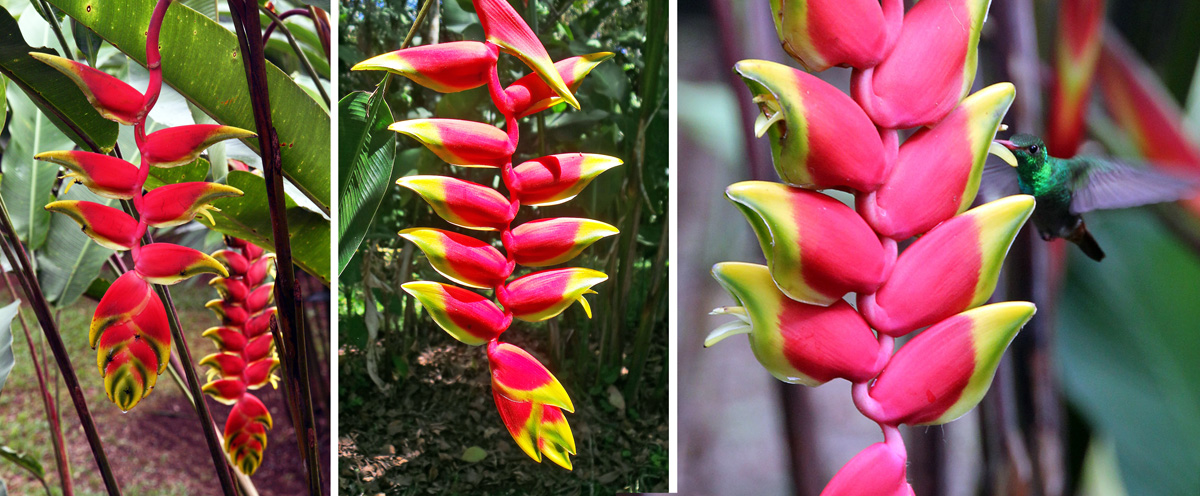
Protea cynaroides, king protea, is South Africa’s national flower. This woody shrub with thick stems and glossy, evergreen leaves is adapted to regeneration after wildfires in its native fynbos environment, resprouting new stems from buds in the thick underground stem after a fire. This species in the ancient southern hemisphere plant family Proteaceae has the largest inflorescence of the genus. The resemblance of the flower bud to that of a globe artichoke (Cynara scolymus) was the inspiration of the species name cynaroides. With a relatively wide distribution (compared to most proteas) in a variety of habitats and climatic conditions, this species has great natural variation. Stiff, pointed, showy bracts that can range in color from white to pale pink with a silvery sheen to deep crimson surround the domed, central mass of tepaled inner flowers. Nectivorous birds, mainly sunbirds and sugarbirds, pollinate the flowers when the bird pushes is bill into the inflorescence to get the nectar, dusting its face with pollen. Many bees and some beetles are also attracted to the flowers. It makes a long-lasting cut flower and can be used as a dried flower. There are many selected varieties grown as ornamentals within and beyond its natural range, with significant commercial production in New Zealand, Australia and Hawaii.

Here are three more which I’ve only seen planted in gardens or conservatories, but would love to encounter in the wild:
Holmskioldia sanguinea is a rambling shrub in the mint family (Lamiaceae) native to the Himalayan lowlands, that is widely cultivated as an ornamental in mild climates. At first the evergreen plant grows erect, but eventually the branches weep to create an almost vine-like appearance. It flowers throughout the year, but most heavily in the dry season. The common names of Chinese hat plant, cup and saucer plant or parasol flower allude to the unusual shape of the flowers. Dense clusters of flowers are produced between the leaves along the stems, often in groups of six, each with a broad, circular, hat-like, dark orange or red calyx surrounding a narrow red tubular flower which are pollinated by butterflies. The variety ‘Citrina’ produces yellow flowers and there are bronze-flowered forms. Only hardy to zone 9, it can be grown in containers.
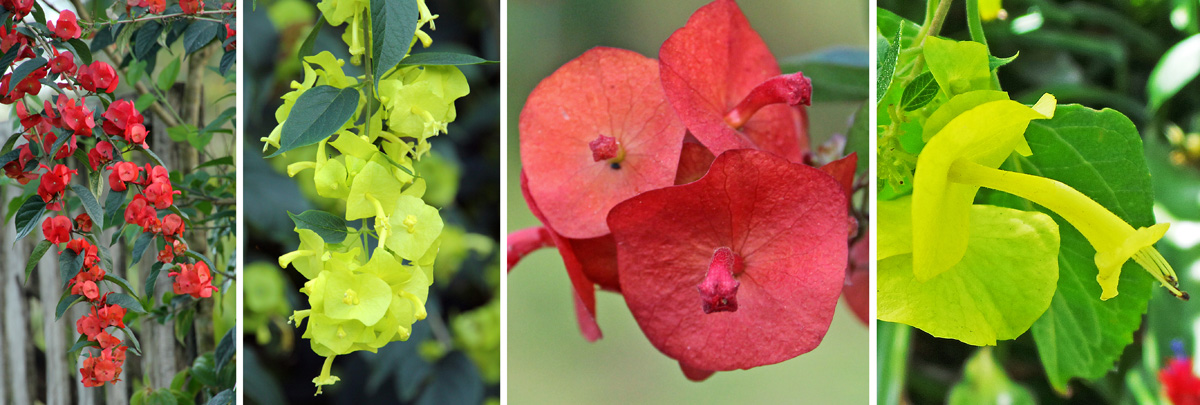
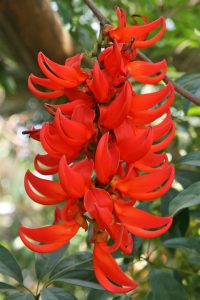
Strongylodon macrobotrys is a leguminous liana (woody tropical vine) native to tropical forests of the Philippines that is frequently used as an ornamental in tropical and subtropical gardens for the showy flowers. The common name of jade vine, emerald vine or turquoise jade vine, describes the color of the translucent flowers which vary from aquamarine to jade green, eventually changing to purple as they dry out. The waxy flowers are borne in pendent clusters (pseudoracemes) of 75 or more flowers. Each claw-shaped flower supposedly resembles a stout-bodied butterfly with folded wings. The flowers are pollinated by bats, which get dusted with pollen when hanging upside down to drink the nectar. Red jade vine is an unrelated species, Mucuna bennetti, from Papua New Guinea which has flowers of the same shape that are red instead of green.
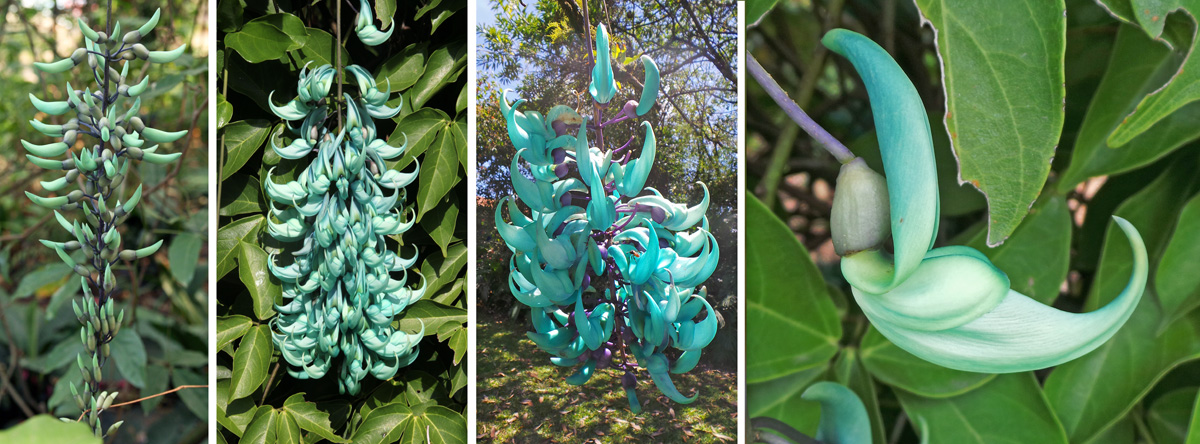
Tacca chantrieri, native to tropical forests of southeast Asia, belongs to the yam family Dioscoreaceae, but it looks nothing like a sweet potato. The common names of bat flower, black batflower, bat-head lily, devil flower, or cat’s whiskers come from the dark purple, almost black, color of the lily-like inflorescences with bracts up to a foot across that resemble wings, and threadlike bracteoles that hang from the flowers like foot-long whiskers. T. integrifolia, white batflower, is a larger plant which produces clusters of 20-40 black flowers with purple-veined white bracts that look like bat ears. These tender species can be grown in containers with ample humidity and moderate light.

Of course this is not an exhaustive list and is highly subjective, depending on your preferences and perspectives. What other flowers would YOU add to this list?
– Susan Mahr, University of Wisconsin – Madison
Additional Information
- Aristolochia grandiflora – on the UW (Washington) Greenhouse insiders website
- Devil’s Hand Tree – on the Global Trees Campaign website
- Ferraria – on the Pacific Bulb Society website
- Passiflora incarnata – on the Floridata website
- Protea cynaroides – on the PlantZAfrica website
- Stapelia – on the PlantZAfrica website
- Stapelia gigantea – on the Missouri Botanic Garden’s Kemper Center for Home Gardening website
- Strongylodon macrobotrys – on the Floridata website





 Alternatives to Lawn: Groundcovers
Alternatives to Lawn: Groundcovers Marigolds
Marigolds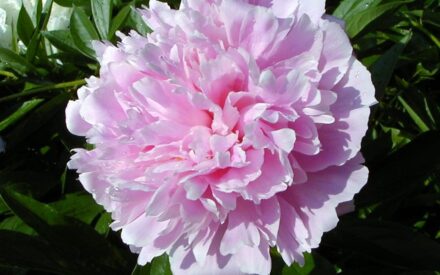 Peony
Peony Iris Severe Mosaic
Iris Severe Mosaic


